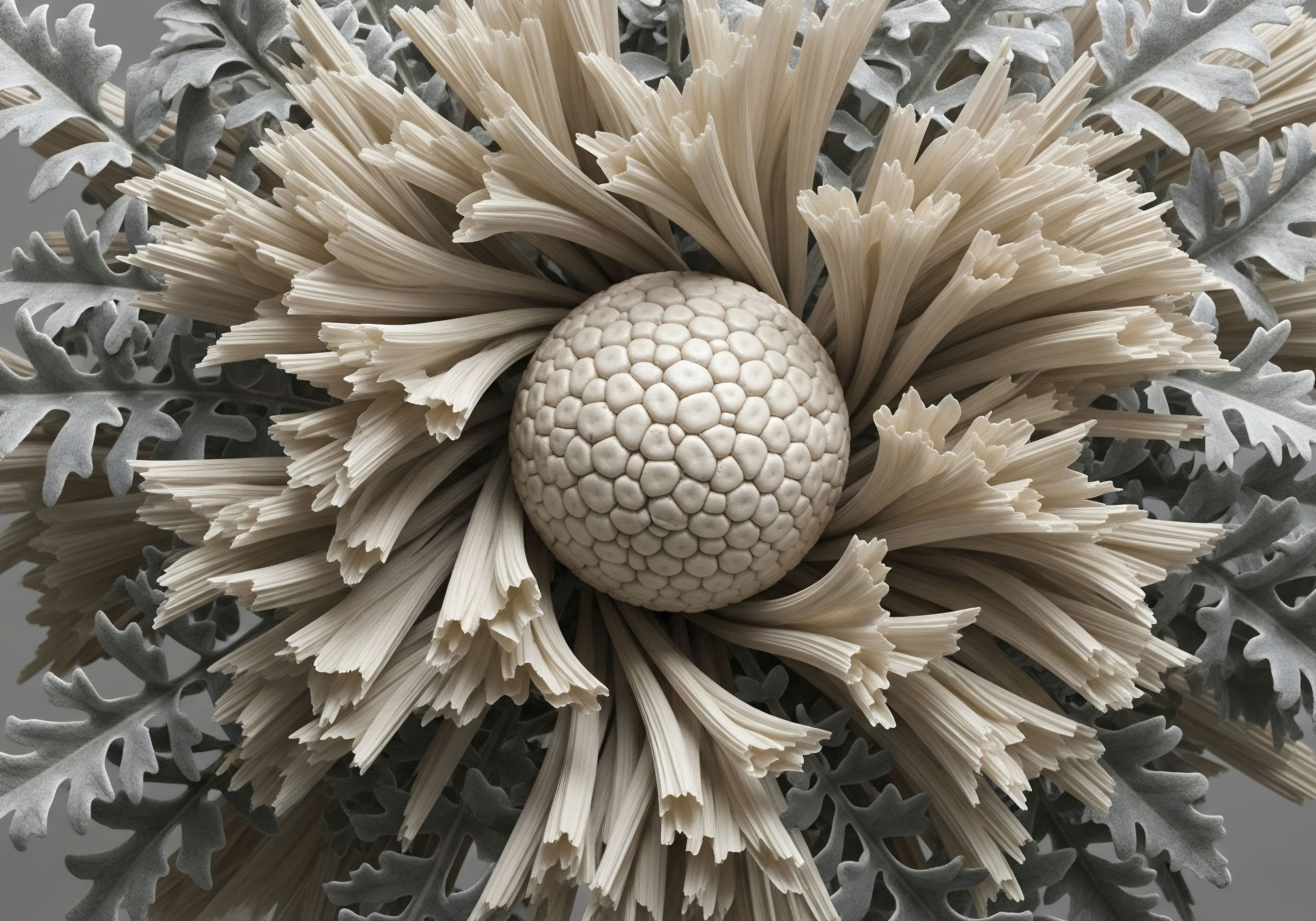

Fundamentals
You feel it as a subtle shift in the current of your own life. The energy that once felt boundless now seems to have a daily limit. Recovery from a strenuous workout takes a day longer than it used to. The mental sharpness that defined your professional life now occasionally feels clouded by a thin veil of fatigue.
These experiences are not imagined; they are the perceptible result of deep, intricate, and entirely normal biological processes. Your body is a system of communication, a network of signals that has operated with precision for decades. The changes you perceive are the outcome of a gradual modulation in that conversation.
One of the most significant voices in this internal dialogue is growth hormone (GH), a molecule that orchestrates cellular repair, metabolic efficiency, and tissue regeneration. Its decline with age is a predictable aspect of human physiology, a key reason why the vitality of youth recedes.
Understanding this prompts a logical question ∞ if a decline in this specific hormone contributes to the feelings associated with aging, can replacing it reverse the process? This line of reasoning has led many to inquire about using recombinant human growth hormone (HGH) as an “anti-aging” agent.
It is a direct, seemingly simple solution to a complex biological shift. The appeal is undeniable because it speaks to a deep human desire to maintain function, to live with vigor, and to align how we feel on the inside with our enduring sense of self.
Your concerns about these changes are valid, and seeking solutions is a proactive step toward stewarding your own health. The exploration of HGH is an entry point into a much larger and more sophisticated understanding of how to support the body’s systems for the long term.
The conversation around growth hormone for anti-aging begins with validating the real, lived experiences of diminished vitality and connecting them to the body’s changing internal chemistry.

What Is the Biological Role of Growth Hormone?
Growth hormone is a protein produced by the pituitary gland, a small, powerful structure at the base of the brain that acts as a master controller for the endocrine system. GH’s primary role during childhood and adolescence is to stimulate growth, as its name suggests.
It achieves this by traveling through the bloodstream to the liver, where it triggers the production of another powerful signaling molecule ∞ insulin-like growth factor 1 (IGF-1). It is largely IGF-1 that travels to tissues throughout the body, instructing bone, cartilage, and muscle cells to grow and divide. This GH to IGF-1 signaling cascade is known as the somatic axis, and it is central to our development.
In adulthood, after linear growth has completed, GH continues to play a vital role in metabolic regulation and body composition. It helps maintain muscle mass, supports bone density, influences fat distribution, and contributes to the repair of tissues. The release of GH is not constant.
It follows a natural, pulsatile rhythm, with the largest bursts occurring during deep sleep. This pulsatility is a critical feature of its biological function. The body’s cells are designed to listen for these intermittent signals, which prevents them from becoming desensitized and ensures a balanced response. This rhythmic communication is a hallmark of a healthy, youthful endocrine system.

The Legal and Ethical Landscape
The discussion about using HGH for anti-aging must include its legal status. In the United States, the Food, Drug, and Cosmetic Act was amended in 1990 to specifically address the distribution of human growth hormone. This legislation makes it illegal to distribute HGH for uses not specifically approved by the FDA.
Approved uses include treating adult growth hormone deficiency (a diagnosable medical condition), muscle wasting in HIV/AIDS patients, and short bowel syndrome. The use of HGH for “anti-aging” or for age-related decline is explicitly not an approved indication.
This legal framework was established based on a careful consideration of the scientific evidence and the risk-benefit profile of the therapy. While physicians have the discretion to prescribe many medications “off-label” for unapproved uses, the law surrounding HGH is uniquely restrictive.
This reflects a significant public health concern about the potential for harm when a powerful hormone is used without a clear medical necessity. The ethical dimension of this issue is therefore deeply intertwined with the legal one. Justifying its use requires navigating a complex terrain of patient autonomy, the physician’s duty to “do no harm,” and the robust scientific data that points toward significant long-term risks, which we will explore in greater detail.


Intermediate
To truly grasp the ethical complexities of using exogenous growth hormone for anti-aging, we must move beyond the simple fact of its decline and examine the character of its action. The human endocrine system is a model of sophisticated regulation, relying on feedback loops and pulsatile secretions to maintain a state of dynamic equilibrium.
The introduction of an external, non-pulsatile hormone signal is a fundamentally different biological event than the restoration of the body’s own natural rhythm. It is the difference between shouting a single, sustained command at a complex system versus helping that system recall its own nuanced language.
The core of the issue lies in the body’s response to different signaling patterns. Youthful physiology is characterized by high-amplitude pulses of GH, primarily at night, followed by periods of very low levels. This “on-off” signaling is crucial.
It activates cellular repair and metabolic processes and then allows the system to reset, preventing receptor downregulation and cellular exhaustion. Administering a standard dose of injectable HGH creates a supraphysiological state ∞ a high, stable plateau of GH levels that the body never experiences naturally. This sustained, unnatural signal can lead to a cascade of unintended consequences, altering insulin sensitivity, fluid balance, and, most critically, the delicate balance between cellular growth and surveillance.

Physiological Pulses versus Supraphysiological Plateaus
The distinction between restoring a natural pulse and creating an artificial plateau is the central scientific argument against the use of exogenous HGH for general anti-aging. The body’s wisdom is in the rhythm, not just the presence, of the hormone. The following table contrasts the biological effects of these two different signaling patterns.
| Feature | Endogenous Pulsatile GH Release (Youthful Physiology) | Exogenous HGH Administration (Anti-Aging Protocol) |
|---|---|---|
| Signal Pattern |
High-amplitude bursts, primarily during deep sleep, followed by very low trough levels. |
Creates a sustained, elevated plateau of GH and IGF-1 levels throughout the day and night. |
| Pituitary Feedback |
Operates within a negative feedback loop. High IGF-1 levels signal the pituitary to reduce GH secretion, maintaining balance. |
Bypasses the natural feedback loop. The pituitary gland receives a signal of high IGF-1 and may reduce its own production of GH over time. |
| Cellular Response |
Maintains receptor sensitivity. Cells are activated by the pulse and then reset during the trough, ensuring an appropriate response. |
Can lead to receptor desensitization and cellular resistance. The constant signal overwhelms the receptors, diminishing their responsiveness. |
| Metabolic Effects |
Promotes transient insulin resistance to mobilize energy, balanced by periods of normal sensitivity. Supports healthy body composition. |
Associated with a higher risk of persistent insulin resistance, fluid retention, joint pain (arthralgia), and carpal tunnel syndrome. |
| Long-Term Risks |
Supports healthy tissue maintenance and repair within a regulated system. |
Sustained high IGF-1 levels are linked in epidemiological studies to an increased risk of certain cancers. |

A More Intelligent Approach Growth Hormone Peptides
Recognizing the limitations and risks of exogenous HGH has led to the development of a more sophisticated class of therapies ∞ growth hormone peptides. These are small protein chains that work by stimulating the body’s own pituitary gland to produce and release its own growth hormone.
They do not replace the body’s GH; they encourage its natural production, preserving the crucial pulsatile rhythm that is the hallmark of healthy endocrine function. This approach represents a fundamental shift from hormonal replacement to hormonal restoration.
There are two primary classes of these peptides used in clinical practice:
- Growth Hormone-Releasing Hormone (GHRH) Analogs ∞ These peptides, such as Sermorelin and CJC-1295, mimic the body’s own GHRH. They bind to GHRH receptors on the pituitary gland, prompting it to secrete a pulse of GH. This action respects the body’s innate feedback mechanisms. If downstream IGF-1 levels become too high, the body’s natural inhibitory signals (like somatostatin) will still function to prevent excessive release.
- Growth Hormone Secretagogues (GHS) or Ghrelin Mimetics ∞ This class includes peptides like Ipamorelin and Hexarelin. They work on a different but complementary pathway by mimicking the hormone ghrelin. Ipamorelin binds to the GHS-receptor on the pituitary, also triggering a release of GH. A key advantage of Ipamorelin is its selectivity; it stimulates a strong GH pulse without significantly affecting other hormones like cortisol (the stress hormone) or prolactin.
Often, these two types of peptides are used in combination, for instance, CJC-1295 and Ipamorelin. This dual-action protocol can produce a synergistic effect, resulting in a stronger, but still physiological, pulse of GH release. This is the therapeutic frontier for age management ∞ using biologically intelligent molecules to restore a youthful signaling pattern, rather than overwhelming the system with a constant, external supply of a powerful hormone.
Modern peptide therapies work by prompting the body to restore its own natural, pulsatile release of growth hormone, a stark contrast to the supraphysiological state created by direct HGH injections.

Comparing Common Growth Hormone Peptides
The choice of peptide protocol depends on the specific goals of the individual and their unique physiology. Each peptide has a different half-life, mechanism, and clinical profile. Understanding these differences is key to appreciating the level of precision possible with this therapeutic approach.
| Peptide | Mechanism of Action | Half-Life | Primary Clinical Use |
|---|---|---|---|
| Sermorelin |
GHRH Analog. Mimics natural GHRH to stimulate a GH pulse. |
Very short (~10-20 minutes). Produces a quick, clean pulse. |
Often used as a starting point for anti-aging protocols to gently restore natural GH secretion, particularly improving sleep quality. |
| CJC-1295 (No DAC) |
GHRH Analog. A modified version of GHRH with greater stability than Sermorelin. |
Short (~30 minutes). Allows for multiple daily pulses if desired. |
Frequently combined with Ipamorelin for a synergistic, strong GH pulse, typically administered once daily before bed. |
| CJC-1295 (with DAC) |
GHRH Analog with Drug Affinity Complex. DAC allows the peptide to bind to blood proteins. |
Very long (~7-8 days). Creates a sustained elevation in baseline GH and IGF-1 levels. |
Used for convenience with once or twice weekly dosing. Its sustained action is a departure from pure pulsatility. |
| Ipamorelin |
Selective GHS. Mimics ghrelin to stimulate a GH pulse without affecting cortisol or prolactin. |
Short (~2 hours). Provides a clean and targeted GH release. |
Valued for its high safety profile and specificity. Almost always used in combination with a GHRH analog like CJC-1295. |


Academic
The ethical justification for any medical intervention hinges on a rigorous, evidence-based assessment of its risk-to-benefit ratio. In the context of administering supraphysiological doses of recombinant human growth hormone (rHGH) for age-related decline, a deep dive into the molecular biology of the GH/IGF-1 axis reveals a profound and troubling paradox.
The very pathway that drives youthful growth and cellular vitality is mechanistically linked to the processes that promote carcinogenesis and potentially accelerate certain aspects of aging. This concept, known as antagonistic pleiotropy, posits that genes and pathways selected for their benefits in early life can have detrimental effects in later life. The GH/IGF-1 axis is a textbook example of this principle.
Administering exogenous rHGH to a healthy, aging individual effectively forces this pleiotropic trade-off. While users may experience short-term improvements in lean body mass and body fat composition, they are simultaneously activating signaling cascades that are highly conserved drivers of cellular proliferation and inhibitors of apoptosis (programmed cell death).
This intervention bypasses the body’s sophisticated regulatory architecture, which has evolved to carefully gatekeep these powerful effects. From a scientific standpoint, this is a crude manipulation of a deeply complex system, with the potential for significant iatrogenic harm.

What Is the Link between IGF-1 Signaling and Cancer?
The primary mediator of most of GH’s anabolic and proliferative effects is Insulin-Like Growth Factor 1 (IGF-1). Circulating IGF-1 levels are tightly regulated by GH. When exogenous rHGH is administered, liver production of IGF-1 increases, leading to sustained high levels throughout the body. The IGF-1 receptor (IGF-1R) is present on the surface of nearly all cell types. When activated by IGF-1, it triggers two major intracellular signaling pathways:
- The PI3K/Akt/mTOR Pathway ∞ This is a central regulator of cell growth, proliferation, and survival. The mammalian Target of Rapamycin (mTOR) is a key protein kinase in this cascade. Its activation promotes protein synthesis and cell growth while actively suppressing autophagy, the body’s essential process for clearing out damaged cellular components. Chronic activation of the mTOR pathway is a well-established hallmark of many cancers. Studies in multiple model organisms have shown that inhibiting mTOR (for example, with the drug rapamycin) can extend lifespan.
- The Ras/Raf/MAPK Pathway ∞ This pathway is primarily involved in stimulating cell division (mitogenesis). Aberrant activation of this pathway is another common feature of cancer, as it can override the normal checkpoints that control the cell cycle.
Epidemiological studies in humans have consistently demonstrated a correlation between high-normal or elevated IGF-1 levels and an increased risk for several common cancers, including breast, prostate, and colorectal cancer.
The biological plausibility is clear ∞ sustained high levels of IGF-1 provide a constant mitogenic and anti-apoptotic signal, creating a permissive environment for a cell that has acquired a cancerous mutation to survive, proliferate, and form a tumor. The use of rHGH for anti-aging directly and intentionally elevates this risk factor.

Lessons from Nature Laron Syndrome and Longevity
Perhaps the most compelling evidence against the “more GH is better” paradigm comes from studying individuals with natural genetic mutations that disrupt the GH/IGF-1 axis. Laron Syndrome is a rare form of dwarfism caused by a mutation in the growth hormone receptor (GHR).
Individuals with this condition cannot respond to GH, resulting in extremely low levels of IGF-1 throughout their lives. Despite other health issues, population studies of individuals with Laron Syndrome have revealed a remarkable finding ∞ they appear to be almost completely protected from developing cancer.
This natural human experiment provides a powerful counterargument to the goals of anti-aging HGH therapy. It demonstrates that lifelong, severe IGF-1 deficiency, while detrimental to developmental growth, confers a profound resistance to age-related malignancy.
This observation aligns with longevity research in lower organisms, where downregulation of the equivalent of the GH/IGF-1 signaling pathway is one of the most consistent ways to extend lifespan. These findings suggest that the natural decline of the GH/IGF-1 axis with age may be a protective, adaptive mechanism, evolved to reduce cancer risk during the post-reproductive years.
Intentionally reversing this decline with exogenous rHGH runs directly contrary to the lessons taught by both human genetics and fundamental aging research.
Human studies on conditions like Laron Syndrome reveal that a lifelong deficiency in IGF-1 signaling confers a powerful protection against cancer, challenging the core premise of anti-aging growth hormone therapy.

How Does Chinese Law Regulate Off-Label HGH Use?
The regulatory environment in China presents a different and complex picture. While the United States has specific federal laws criminalizing the distribution of HGH for anti-aging, the legal framework in China is less explicit and enforcement can be inconsistent. The National Medical Products Administration (NMPA), China’s equivalent of the FDA, approves medications for specific indications.
HGH is approved for pediatric growth disorders and adult GHD. The off-label use of medications is a widespread practice in Chinese clinical settings, often guided by physician experience and hospital guidelines rather than strict national mandates.
This creates a gray market where HGH can be obtained for anti-aging purposes, often through private clinics or online channels. The ethical justification in this context becomes a matter of professional and commercial practice. The lack of clear legal prohibition may be interpreted by some practitioners as tacit permission.
However, the underlying scientific risks remain the same regardless of the regulatory landscape. The commercial incentives to promote HGH for anti-aging are substantial, potentially creating a conflict of interest that can obscure an objective assessment of the medical evidence. The ethical burden then falls heavily on the individual physician to prioritize patient safety over commercial opportunity, a challenge in any healthcare system.

The Superior Ethical Stance of Biomimetic Restoration
Given the significant, mechanistically-grounded risks of supraphysiological rHGH administration, the ethical justification for its use in healthy aging individuals is exceptionally weak. The intervention is illegal in some jurisdictions for sound public health reasons, and it runs counter to fundamental principles of aging biology. It prioritizes a short-term cosmetic and compositional benefit over a long-term increase in oncological risk.
The development of growth hormone peptides like Sermorelin, CJC-1295, and Ipamorelin offers a scientifically and ethically superior alternative. These therapies are biomimetic; they work with the body’s own regulatory systems. By stimulating a natural, pulsatile release of GH, they restore a more youthful signaling pattern without completely overriding the essential negative feedback loops that protect against excess.
This approach inherently carries a lower risk profile because the body retains a degree of control. The ethical argument for these peptides is stronger because their primary goal is the restoration of physiological function, a principle that aligns with the Hippocratic duty to work in concert with the body’s healing capacities.
The choice is between a blunt instrument that forces a biological pathway into a state of constant, risky activation, and a set of sophisticated tools designed to gently coax that pathway back into its own healthy, natural rhythm.

References
- Bartke, Andrzej. “Growth hormone and aging ∞ a challenging controversy.” Clinical Interventions in Aging, vol. 3, no. 4, 2008, pp. 659-665.
- Cohen, Pinchas. “The IGF-I axis and longevity ∞ a new perspective on an old story.” Growth Hormone & IGF Research, vol. 18, no. 6, 2008, pp. 459-461.
- Guevara-Aguirre, Jaime, et al. “Growth Hormone Receptor Deficiency is Associated with a Major Reduction in Pro-Aging Signaling, Cancer, and Diabetes.” Science Translational Medicine, vol. 3, no. 70, 2011, p. 70ra13.
- Ionescu, M. and L. A. Frohman. “Pulsatile secretion of growth hormone (GH) persists during continuous stimulation by CJC-1295, a long-acting GH-releasing hormone analog.” The Journal of Clinical Endocrinology & Metabolism, vol. 91, no. 12, 2006, pp. 4792-4797.
- Raun, K. et al. “Ipamorelin, the first selective growth hormone secretagogue.” European Journal of Endocrinology, vol. 139, no. 5, 1998, pp. 552-561.
- Powers, J. M. “The case against ‘off-label’ prescribing.” Virtual Mentor, vol. 8, no. 10, 2006, pp. 699-702.
- Perls, Thomas T. et al. “The new drug cocktails and the marketing of ‘anti-aging’ medicine to baby boomers.” JAMA, vol. 294, no. 16, 2005, pp. 2086-2090.
- Anisimov, Vladimir N. and Mikhail V. Baturin. “The influence of growth hormone and related peptides on aging and carcinogenesis.” Current Topics in Peptide & Protein Research, vol. 5, 2002, pp. 135-154.
- Teichman, Sam L. et al. “Prolonged stimulation of growth hormone (GH) and insulin-like growth factor I secretion by CJC-1295, a long-acting analog of GH-releasing hormone, in healthy adults.” The Journal of Clinical Endocrinology & Metabolism, vol. 91, no. 3, 2006, pp. 799-805.
- Laron, Zvi. “The essential role of IGF-1 ∞ lessons from the long-term study and treatment of children and adults with Laron syndrome.” The Journal of Clinical Endocrinology & Metabolism, vol. 84, no. 12, 1999, pp. 4397-4404.

Reflection

Charting Your Own Path to Vitality
The information presented here provides a map of a complex biological territory. It details the signals, the pathways, and the delicate regulatory mechanisms that govern your vitality. You began this inquiry with a valid and important question, driven by a desire to feel your best.
The journey through the science of growth hormone, IGF-1, and cellular aging leads to a clear conclusion. The initial, seemingly logical idea of replacing a declining hormone reveals itself to be a crude intervention with significant, well-documented risks.
This knowledge is the first and most critical tool in your possession. It allows you to move beyond simplistic solutions and ask more sophisticated questions. Instead of asking “How can I replace what is lost?”, you can now ask, “How can I best support and restore my body’s own innate systems for health and repair?”.
The answer to this new question is deeply personal. It involves a comprehensive understanding of your unique biochemistry, genetics, and lifestyle. It points toward a path of personalized medicine, where interventions are chosen not because they are popular, but because they are precisely suited to your body’s needs.
This path may involve targeted peptide therapies that respect your natural physiology. It will certainly involve optimizing the foundational pillars of health ∞ nutrition, sleep, exercise, and stress management, all of which have a profound impact on your endocrine system. The ultimate goal is to cultivate a state of health that is resilient, sustainable, and authentic to you.
The power to achieve this lies in the synthesis of scientific knowledge and self-awareness, creating a partnership with your own biology to foster a lifetime of function and vitality.



